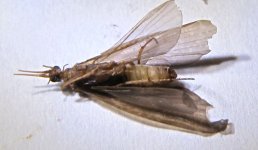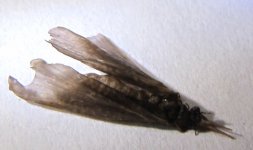henrydavid
Member
- Joined
- Mar 24, 2007
- Messages
- 627
I'm reading up on caddis hatches and some of what I'm reading is enlightening and seems to match exactly what I saw on the stream 2 days ago.
I saw nothing in the air or on the water at first and no rises, after just a bit I started to spot 1, then 2, just here and there, grannoms I assumed. During this time I was drifting a copper john nymph and not getting a single touch, I finally got a nice strike on a swing and figured it was time to give the nymph some action.
I hooked up after just a few attempts and got a nice brown. Shortly after another miss, then I started noticing more grannoms in the air. Not thinking the situation through I switched to a dry caddis imitation after capturing a couple of the insects.
To clarify the color they appeared greyish and brown on the wings and a lighter tan body. I tried desperately to imitate them and finally got a small wild brown but nothing else even came close to it.
After getting home I figured I would've been better off keeping with the swimming nymph. There eventually came a near blizzard of grannoms but in hindsight I don't think they were on the water and the trout were not taking them.
Just a near swarm of them moving upstream, just like what I read about, they move upstream to distribute themselves throughout rather than all ending up at the mouth or dam.
I did see several trout rising and something else that made me wonder, a few coming completely out of the water. Where those trout taking the swimming nymphs and catapulting themselves out of the water in the process?
I'd love some input, are the dry fly imitations of the grannoms to be ignored if they are moving upstream and off the water?
What would be your choice of nymph patterns and any tips on the action to impart on them.
I saw nothing in the air or on the water at first and no rises, after just a bit I started to spot 1, then 2, just here and there, grannoms I assumed. During this time I was drifting a copper john nymph and not getting a single touch, I finally got a nice strike on a swing and figured it was time to give the nymph some action.
I hooked up after just a few attempts and got a nice brown. Shortly after another miss, then I started noticing more grannoms in the air. Not thinking the situation through I switched to a dry caddis imitation after capturing a couple of the insects.
To clarify the color they appeared greyish and brown on the wings and a lighter tan body. I tried desperately to imitate them and finally got a small wild brown but nothing else even came close to it.
After getting home I figured I would've been better off keeping with the swimming nymph. There eventually came a near blizzard of grannoms but in hindsight I don't think they were on the water and the trout were not taking them.
Just a near swarm of them moving upstream, just like what I read about, they move upstream to distribute themselves throughout rather than all ending up at the mouth or dam.
I did see several trout rising and something else that made me wonder, a few coming completely out of the water. Where those trout taking the swimming nymphs and catapulting themselves out of the water in the process?
I'd love some input, are the dry fly imitations of the grannoms to be ignored if they are moving upstream and off the water?
What would be your choice of nymph patterns and any tips on the action to impart on them.







